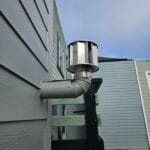Imagine you’re ready for a warm shower after a long day, only to find the water is ice cold. You check your water heater and discover that the pilot light has gone out again, all because of the wind.
Frustrating, isn’t it? But you’re not alone. Many people face this issue, and the good news is, there are simple solutions that can help you stop the wind from blowing out the pilot light on your water heater. We’ll explore practical tips and tricks that you can implement right away.
You’ll learn how to protect your pilot light and ensure consistent hot water, saving you both time and stress. By the end, you’ll feel empowered to tackle this annoying problem with ease and confidence. So, let’s dive in and solve this pesky problem once and for all!

Credit: www.h2ouse.org
Common Causes Of Pilot Light Issues
Windy conditions can extinguish a water heater’s pilot light. Shield the area around the heater to prevent this. Ensure the flame is steady by securing the vent or using a draft hood.
A flickering pilot light on your water heater can be a real hassle, especially when the wind is determined to snuff it out. Understanding the common causes of pilot light issues can save you time and frustration. By knowing what to look for, you can keep your water heater running smoothly and avoid those chilly showers. Let’s dive into some of the usual suspects.Drafts And Airflow Problems
One of the main reasons your pilot light might keep going out is due to drafts. Even a slight breeze can extinguish the flame. Check for any open windows or doors near your water heater. Are there any gaps or cracks in the walls that could let in air? I remember the time my own pilot light kept going out every time there was a storm. It turned out, a small crack in the basement window was letting in enough wind to cause trouble. Sealing that crack made all the difference. Another thing to consider is the airflow around your water heater. Make sure there’s nothing obstructing it. A cluttered basement or utility room can create unexpected airflow problems. Keeping the area clear can prevent these kinds of issues.Faulty Components
Sometimes, the culprit isn’t the wind, but the water heater itself. Faulty components can lead to a pilot light that won’t stay lit. Common problem areas include the thermocouple, gas valve, or even the pilot tube. The thermocouple is a safety device that senses if the pilot light is on. If it’s not working properly, it can mistakenly shut off the gas supply. Replacing a faulty thermocouple is often a straightforward fix. The gas valve might also be to blame. If it’s not opening fully, your pilot light might not get enough gas to stay lit. Consider having a professional check the gas valve if you suspect this is the issue. Have you noticed any unusual noises or a weak flame? These could be signs of a blocked pilot tube. Cleaning it could resolve the problem. Being proactive about these potential issues can keep your water heater in tip-top shape. Are there any other quirks your water heater has that could be causing trouble? Identifying them early can prevent bigger problems down the line.Preparing Your Space
Creating a wind barrier can protect the pilot light. Use a metal shield or wind guard to block drafts. Ensure proper ventilation to prevent gas buildup while keeping the flame steady.
A gusty wind can be a constant annoyance when it keeps blowing out the pilot light on your water heater. One effective way to tackle this issue is by preparing your space to shield against drafts. By making a few strategic changes, you can create a more stable environment where the pilot light can stay lit, providing you with consistent access to hot water.Sealing Windows And Doors
Start by examining your windows and doors for any gaps or cracks that might let in drafts. Even small openings can allow enough air to disturb your pilot light. Use weather stripping or caulk to seal these areas effectively. Consider using draft stoppers at the base of doors to block air from sneaking in. This simple change can make a significant difference. Have you ever noticed how a tiny draft can chill a room? Now imagine what it can do to a small flame. Regularly check these seals, especially before the windy seasons. A quick inspection can save you from the hassle of relighting your pilot light repeatedly.Installing Windbreaks
Installing windbreaks around your water heater can provide an added layer of protection. If your water heater is located in a garage or an outdoor shed, this becomes even more crucial. Windbreaks can be as simple as a fence or a screen that diverts the wind away. Think about how a garden fence shields plants from harsh winds. Your water heater deserves the same care. Position these barriers strategically to ensure they don’t block access for maintenance. Consider using materials like plywood or vinyl panels, which are sturdy and easy to install. These can be temporary or permanent, depending on your needs. You might be surprised at how this small project can lead to more reliable hot water availability. By taking these steps to prepare your space, you can enjoy the peace of mind that comes with a consistently lit pilot light. What other small changes could make a big difference in your home?Enhancing Pilot Light Stability
Keeping the pilot light stable is crucial for a water heater’s efficiency. Wind can disrupt this stability, causing frustration. Solutions exist to minimize disruptions and enhance pilot light stability. These solutions focus on practical adjustments and protective measures.
Adjusting Flame Settings
Flame settings impact the pilot light’s performance. The flame needs to be strong enough to withstand gusts. A weak flame blows out easily, leading to frequent relighting. Check the flame’s color and strength. A blue flame indicates optimal performance. If the flame is yellow, adjust it to prevent blowing out.
To adjust, locate the flame control knob. Turn it slightly to increase flame strength. Avoid making the flame too large. This could cause overheating or damage. Regularly check the flame to ensure stability.
Using Protective Covers
Protective covers shield the pilot light from direct wind exposure. These covers are designed to encase the pilot light area. They reduce the impact of sudden gusts. Choose a cover that fits snugly around the pilot assembly.
Install the cover according to the instructions. Ensure it does not block necessary airflow. A well-fitted cover keeps the pilot light stable. It prevents frequent outages and ensures consistent heating.

Credit: www.doityourself.com
Maintenance And Inspection
Keeping your water heater’s pilot light from being snuffed out by gusty winds isn’t just about quick fixes; it’s about long-term care through maintenance and inspection. Regular check-ups can make all the difference in ensuring your heater runs smoothly. By paying attention to details and keeping an eye out for potential issues, you can save time and money while enjoying a reliably warm home.
Regular Cleaning
A clean water heater is a happy water heater. Dirt and debris can obstruct parts of the heater, affecting its performance and making it easier for wind to extinguish the pilot light. Take time every few months to wipe down the exterior and vacuum around the base.
Don’t forget the burner compartment. Dust and lint can accumulate here, leading to clogs and inefficiencies. Use a small brush or compressed air to gently clean this area.
Have you ever noticed how a dusty corner of your home feels neglected? Your water heater feels the same way. Regular cleaning not only helps prevent problems but also extends the lifespan of your appliance.
Checking For Damage
Inspect your water heater for any signs of damage. Look for cracks or holes that might allow wind to enter and interfere with the pilot light. Even a small gap can be an open door for trouble.
Examine the venting system. This crucial component directs harmful gases away from your home. Ensure it’s free from blockages and securely attached.
Imagine if a window in your home was permanently ajar. That’s what a faulty vent can be like for your water heater. A quick check could prevent bigger issues down the line.
Also, pay attention to the pilot assembly. If it’s bent or misaligned, it might not shield the flame properly from drafts. A simple adjustment could be all you need to keep your pilot light burning brightly.
By making maintenance and inspection a regular habit, you can enjoy a more efficient and reliable water heater. What steps will you take today to ensure your pilot light stays lit?
When To Call A Professional
A persistent pilot light issue needs professional help. Windy areas can make troubleshooting tricky. Experts ensure safe, effective solutions.
When facing persistent issues with your water heater’s pilot light, knowing when to call a professional is crucial. While some minor problems can be tackled by homeowners, certain situations demand expert attention. Understanding the right time to seek professional help ensures your water heater operates safely and efficiently.Persistent Issues
If the pilot light frequently goes out, it may indicate a deeper problem. Consistent failures suggest underlying issues that need professional diagnosis. A technician can identify the root cause and provide a lasting solution. Regular disruptions in your water heater’s function can lead to more serious issues. Addressing them promptly with expert help prevents costly repairs in the future.Complex Repairs
Some water heater repairs require specialized skills. Complex repairs involve intricate parts and systems that are best handled by a professional. Attempting these repairs without the right knowledge can worsen the situation. Professionals have the tools and expertise to manage intricate fixes safely. They ensure your water heater functions optimally without further complications.
Credit: www.reddit.com
Frequently Asked Questions
Why Does My Water Heater Pilot Light Keep Going Out?
The pilot light may go out due to strong winds or drafts. Check for nearby open windows or doors.
How Can I Shield My Pilot Light From The Wind?
Use a water heater draft hood. It helps block wind and keeps the pilot light lit.
What Are Common Causes Of Pilot Light Issues?
Drafts, dirt in the burner, or faulty thermocouples. Regular maintenance can prevent these issues.
Can Insulation Help Keep The Pilot Light Lit?
Yes, insulating around the water heater can reduce drafts and help maintain a steady flame.
Is It Safe To Relight The Pilot Light Myself?
Yes, but follow the manufacturer’s instructions. If unsure, consult a professional for safety.
Conclusion
Keeping your water heater’s pilot light lit is simple. Block the wind with barriers. They work well. Check for drafts around the heater. Seal them with caulk or tape. Regular maintenance helps too. Clean the area and inspect parts. It prevents issues.
Consider weatherproofing your home. Reduces indoor drafts. Follow these tips for a steady pilot light. Enjoy uninterrupted hot water. A little effort goes a long way. Keep warm and save energy. Your comfort matters. Happy heating!





